Chapter Talk – Fifth Sunday of Lent – April 7, 2019, cycle-C
The gospel for this Sunday is the woman caught in adultery (Jn 8:1-11). It is a gospel passage that moves me deeply for once again we find Jesus communicating an iconoclastic image of God. Jesus’ initial response to those who accuse the woman caught in adultery is ‘silence’: he bends down into the silence, pauses and waits. The ‘pause’ gives space, space for listening, space for the ‘small silent voice of the Spirit’ to speak, to breathe forth its wisdom words.
Jesus’ physical gesture of bending inward and pausing, not immediately responding, disarms the scribes and Pharisees, and reveals their hypocrisy. Bending inward and listening: Jesus writes in the sand. Scripture scholars differ in their views about the meaning of Jesus writing in the sand. I think the writing is secondary to the fact that Jesus takes a silent pause, bends inward, waits, and listens. And then something happens: the silence forms these words in him and he speaks: ‘Who ever has not sinned throw the first stone’. When Jesus straightens up, and looks at the accusers, he embodies in his presence and in his words, the God of love, the God of forgiving love. In Fr. John Donahue’s commentary on this gospel he writes: “Repentance is not something we do, but it allows the forgiving power of God to touch our lives and lead us along new paths” (Hearing the Word of God, p.51). This is what happened to the woman and we hope it has happened to the accusers who in this scene are really trying to find reasons to entrap Jesus. We may wonder if it is not the power of the silent word of God, mediated through Jesus, which causes this woman to turn and opens her to receive the forgiving word.
In the silence Jesus suffers the conflict situation he finds himself in: when he straightens up and faces his accusers their hidden intentions are disarmed, their accusations fall flat and they are given an opportunity to repent, to have a change of heart and mind. The woman repents…what the scribes and Pharisees do is not known, except that they leave the encounter after Jesus’ statement to them. As they leave one by one they see that Jesus has bent over a second time and is once again writing in the sand. After they leave Jesus straightens up again looks at the woman and says: ‘Woman, where are they? Has anyone condemned you’? She replies: ‘No one sir’. And Jesus answers ‘Neither do I. Go and do not commit this sin again’. Notice the economy of words. Notice how the silent pause gives room for the voice of the Spirit to speak words that transform the whole scene.
Von Balthasar in his commentary states: “In the light of Jesus’ silent suffering for all of us, every accusation has to fall silent…” (Light of the Word, p.290). This is the power of God’s forgiving word, that silence, not many explanations, or defensive words or emotional reactions: none of these lead to healing and to life. Pausing, dropping beneath the onslaught of defensive, self-justifying words, gives space and prepares the ground for the healing and the forgiving word to emerge. Sacred pauses, sacred because we stretch to hear not our many words but God’s word to us: ‘Today if you hear God’s word harden not your hearts.’ To clear a way for the voice of the Spirit we need to ‘pause’, to go inward and to listen.
Sr. Kathy DeVico, Abbess


